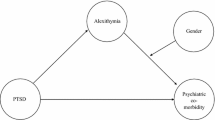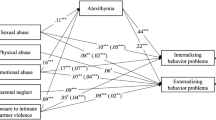Abstract
Child abuse among adolescents in China has been documented and can lead to a whole range of psychological and behavioural problems. This study examined whether male and female adolescents would differ in level of child abuse, emotional processing difficulties, alexithymia, psychological symptoms and behavioural problems, and whether the pattern of association between these variables would vary depending on gender. Eight hundred adolescents were recruited from China and completed the Childhood Trauma Questionnaire, Emotional Processing Scale, Toronto Alexithymia Scale, General Health Questionnaire, and Prediction Test of Problem Children. Male adolescents reported significantly higher levels of emotional and physical neglect, and external oriented thinking style than female adolescents. Females reported significantly more anxiety symptoms and problems with learning than males. For males, child abuse was associated with emotional processing difficulties which were associated with alexithymia. In turn, alexithymia was associated with both psychological and behavioural problems. For females, the same association was established for predicting behavioural problems but not psychological symptoms. Male and female adolescents differed in level of child abuse, alexithymia, psychological symptoms and behavioural problems. These psychological constructs were connected in a specific pattern to trigger psychological and behavioural problems for male adolescents whereas for females, different patterns were involved.


Similar content being viewed by others
References
Brown EJ. Correlates and treatment of stress disorder in children and adolescents. Psychiatr Ann. 2005;35(9):759–65.
Greger HK, Myhre AK, Lydersen S, Jozefiak T. Previous maltreatment and present mental health in a high-risk adolescent population. Child Abuse Negl. 2015;45:122–34.
Manoj J, Thomas J. Prevalence of maltreatment of adolescents among high school children. Merrick, Joav [Ed]; Tenenbaum, Ariel [Ed]; Omar, Hatim A [Ed] (2014) School, adolescence and health issues (pp 139-142) xi, 209 pp Hauppauge, NY, US: Nova Biomedical Books; US. 2014:139–142.
Chen J, Dunne MP, Han P. Child sexual abuse in Henan province, China: associations with sadness, suicidality, and risk behaviors among adolescent girls. J Adolesc Health. 2006;38(5):544–9.
Priebe G, Hansson K, Svedin CG. Sexual abuse and associations with psychosocial aspects of health. A population-based study with Swedish adolescents. Nord J Psychiatry. 2010;64(1):40–8.
Westenberg EA, Garnefski N. Depressive symptomatology and child abuse in adolescents with behavioral problems. Child Adolesc Soc Work J. 2003;20(3):197–210.
Rasmussen CS, Nielsen LG, Petersen DJ, Christiansen E, Bilenberg N. Adverse life events as risk factors for behavioural and emotional problems in a 7-year follow-up of a population-based child cohort. Nord J Psychiatry. 2014;68(3):189–95.
Chung M, Chen Z. Child abuse and psychiatric co-morbidity among Chinese adolescents: emotional processing as mediator and PTSD from past trauma as moderator. Child Psychiatry Hum Dev. 2017;48:610–8.
Arata C, Langhinrichsen-Rohling J, Bowers D, O'Brien N. Differential correlates of multi-type maltreatment among urban youth. Child Abuse Negl. 2007;31:393–415.
Arslan G. Psychological maltreatment, emotional and behavioral problems in adolescents: The mediating role of resilience and self-esteem. Child Abuse & Neglect. 2015: No Pagination Specified.
Ford JD, Elhai JD, Connor DF, Frueh B. Poly-victimization and risk of posttraumatic, depressive, and substance use disorders and involvement in delinquency in a national sample of adolescents. J Adolesc Health. 2010;46(6):545–52.
Garnefski N, Arends E. Sexual abuse and adolescent maladjustment: differences between male and female victims. J Adolesc. 1998;21(1):99–107.
Gore-Felton C, Koopman C, McGarvey E, Hernandez N, Canterbury R. Relationships of sexual, physical, and emotional abuse to emotional and behavioral problems among incarcerated adolescents. Journal of Child Sexual Abuse: Research, Treatment, & Program Innovations for Victims, Survivors, & Offenders. 2001;10(1):73–88.
Kim H-S, Kim H-S, Samuels-Dennis J. The influence of psychosomatic symptoms, physical and sexual abuse, and coping strategies on delinquent behavior among Korean adolescents. Arch Psychiatr Nurs. 2012;26(2):155–64.
Li Y, Cao F-l, Cui N-x, Li Y-l. Child abuse and neglect, executive function, and emotional and behavioral problems in rural adolescents. Chin J Clin Psych. 2012;20(6):813–5.
Moran PB, Davies MK, Toray T. Behavioral, emotional, and psychological outcomes among adolescents in a drug treatment program: a comparison of maltreated and non-maltreated youth. J Child Adolesc Subst Abuse. 1994;4(1):17–33.
Spinazzola J, Hodgdon H, Liang L-J, Ford JD, Layne CM, Pynoos R, et al. Unseen wounds: the contribution of psychological maltreatment to child and adolescent mental health and risk outcomes. Psychol Trauma Theory Res Pract Policy. 2014;6(Suppl 1):S18–28.
Thompson R, Proctor LJ, English DJ, Dubowitz H, Narasimhan S, Everson MD. Suicidal ideation in adolescence: examining the role of recent adverse experiences. J Adolesc. 2012;35(1):175–86.
Feng H, Liu JH, Wang Y, He G. Sociodemographic correlates of behavioral problems among rural Chinese school children. Public Health Nurs. 2011;28:297–307.
Marusak HA, Martin KR, Etkin A, Thomason ME. Childhood trauma exposure disrupts the automatic regulation of emotional processing. Neuropsychopharmacology. 2015;40(5):1250–8.
McLaughlin KA, Peverill M, Gold AL, Alves S, Sheridan MA. Child maltreatment and neural systems underlying emotion regulation. J Am Acad Child Adolesc Psychiatry. 2015;54(9):753–62.
Owens M, Goodyer IM, Wilkinson P, Bhardwaj A, Abbott R, Croudace T et al. 5-HTTLPR and early childhood adversities moderate cognitive and emotional processing in adolescence. PLoS ONE Vol 7(11), Nov 2012, ArtID e48482. 2012;7(11).
Bell KM, Naugle AE. The role of emotion recognition skills in adult sexual revictimization. The Journal of Behavior Analysis of Offender and Victim Treatment and Prevention. 2008;1(4):93–118.
Guenole F, Mallet J-F, Baleyte J-M. Alexithymia in severe idiopathic scoliosis: findings from a cross-sectional study of adolescents who have or have not had operations. J Nerv Ment Dis. 2012;200(3):274.
Scher D, Twaite JA. The relationship between child sexual abuse and alexithymic symptoms in a population of recovering adult substance abusers. Journal of Child Sexual Abuse: Research, Treatment, & Program Innovations for Victims, Survivors, & Offenders. 1999;8(2):25–40.
Rachman S. Emotional processing. Behav Res Ther. 1980;18:51–60.
Pennebaker JW. Emotion, disclosure & health. Washington DC: American Psychological Association; 1995.
Amstadter AB, Vernon LL. A preliminary examination of thought suppression, emotion regulation, and coping in a trauma-exposed sample. J Aggress Maltreat Trauma. 2008;17:279–95.
Gross JJ, John OP. Individual differences in two emotion regulation processes: implications for affect, relationships, and well-being. J Pers Soc Psychol. 2003;85:348–62.
Karukivi M, Hautala L, Kaleva O, Haapasalo-Pesu K-M, Liuksila P-R, Joukamaa M, et al. Alexithymia is associated with anxiety among adolescents. J Affect Disord. 2010;125(1–3):383–7.
van de Putte EM, Engelbert RH, Kuis W, Kimpen JL, Uiterwaal CS. Alexithymia in adolescents with chronic fatigue syndrome. J Psychosom Res. 2007;63(4):377–80.
Zonnevylle-Bender MJ, van Goozen SH, Cohen-Kettenis PT, van Elburg A, de Wildt M, Stevelmans E, et al. Emotional functioning in anorexia nervosa patients: adolescents compared to adults. Depress Anxiety. 2004;19(1):35–42.
Honkalampi K, Tolmunen T, Hintikka J, Rissanen M-L, Kylma J, Laukkanen E. The prevalence of alexithymia and its relationship with youth self-report problem scales among Finnish adolescents. Compr Psychiatry. 2009;50(3):263–8.
Manninen M, Therman S, Suvisaari J, Ebeling H, Moilanen I, Huttunen M, et al. Alexithymia is common among adolescents with severe disruptive behavior. J Nerv Ment Dis. 2011;199(7):506–9.
Gudmundsdottir B, Beck JG. Understanding the pattern of PTSD symptomatology: a comparison of between versus within-group approaches. Behav Res Ther. 2004;42:1367–75.
Kelley LP, Weathers FW, McDevitt-Murphy ME, Eakin DE, Flood AM. A comparison of PTSD symptom patterns in three types of civilian trauma. J Trauma Stress. 2009;22:227–35.
Runyon MK, Faust J, Orvaschel H. Differential symptom pattern of post-traumatic stress disorder (PTSD) in maltreated children with and without concurrent depression. Child Abuse Negl. 2002;26:39–53.
Garnefski N, Diekstra RF. Child sexual abuse and emotional and behavioral problems in adolescence: gender differences. J Am Acad Child Adolesc Psychiatry. 1997;36(3):323–9.
Jaycox LH, Ebener P, Damesek L, Becker K. Trauma exposure and retention in adolescent substance abuse treatment. J Trauma Stress. 2004;17(2):113–21.
Gearing RE, MacKenzie MJ, Schwalbe CS, Brewer KB, Ibrahim RW. Prevalence of mental health and behavioral problems among adolescents in institutional care in Jordan. Psychiatr Serv. 2013;64(2):196–200.
Hebert M, Lavoie F, Vitaro F, McDuff P, Tremblay RE. Association of child sexual abuse and dating victimization with mental health disorder in a sample of adolescent girls. J Trauma Stress. 2008;21(2):181–9.
Tick NT, van der Ende J, Verhulst FC. Ten-year trends in self-reported emotional and behavioral problems of Dutch adolescents. Soc Psychiatry Psychiatr Epidemiol. 2008;43(5):349–55.
Maikovich-Fong AK, Jaffee SR. Sex differences in childhood sexual abuse characteristics and victims' emotional and behavioral problems: findings from a national sample of youth. Child Abuse Negl. 2010;34(6):429–37.
Bernstein DP, Stein JA, Newcomb MD, Walker E, Pogge D, Ahluvalia T, et al. Development and validation of a brief screening version of the childhood trauma questionnaire. Child Abuse Negl. 2003;27:169–90.
Baker R, Thomas S, Thomas PW, Owens M. Development of an emotional processing scale. J Psychosom Res. 2007;26:167–78.
Bagby RM, Parker JDA, Taylor GJ. The twenty-item Toronto alexithymia scale-I: item selection and cross-validation of the factor structure. J Psychosom Res. 1994;38:23–32.
Goldberg D, Hillier V. A scaled version of the general health questionnaire. Psychol Med. 1979;9:139–45.
Goldberg D, Bridges KW. Screening for psychiatric illness in general practice: the general practitioner versus the screening questionnaire. Journal of the Royal College of General Practitioners. 1987;37:15–8.
Zhou B, Zhen F. Prediction test of problem children manual. Shanghai: Press of East China Normal University; 1991.
Hayes AF. Introduction to mediation, moderation and conditional process analysis: a regression-based approach. New York: The Guilford Press. 2013.
Stoltenborgh M, Bakermans-Kranenburg MJ, van Ijzendoorn MH. The neglect of child neglect: a meta-analytic review of the prevalence of neglect. Soc Psychiatry Psychiatr Epidemiol. 2013;48(3):345–55.
Levant RF, Hall RJ, Williams CM, Hasan NT. Gender differences in alexithymia. Psychol Men Masculinity. 2009;10:190–203.
Zhao X. Zhang R-z, Zheng K. gender differences in emotion regulation strategies in adolescents. Chin J Clin Psych. 2014;22(5):849–54.
Breslau N, Chilcoat HD, Kessler RC, Peterson EL, Lucia VC. Vulnerability to assaultive violence: further speculation of the sex difference in post-traumatic stress disorder. Psychol Med. 1999;29:813–21.
Pimlott-Kubiak S, Cortina LM. Gender, victimization and outcomes: Reconceptualizing risk. J Consult Clin Psychol. 2003;71:528–39.
Plutchik R, Kellerman H, Conte HR. A structural theory of ego defenses and emotions. In: Izard CE, editor. Emotions in personality and psychopathology. New York: Plenum Press; 1979. p. 229–57.
Valiant GE. Ego mechanisms of defense, a guide for clinicians and researches. Washington: American Psychiatric Press; 1992.
Levant R. Toward the reconstruction of masculinity. J Fam Psychol. 1992;5:379–402.
Levant RF. Toward the reconstruction of masculinity. In: Levant RF, Pollack WS, editors. A new psychology of men. New York: Basic Books; 1995. p. 229–51.
Levant RF. Desperately seeking language: understanding, assessing, and treating normative male alexithymia. In: Pollack WS, Levant RF, editors. New psychotherapy for men. New York: Wiley; 1998. p. 35–56.
Geller PA, Nelson AR, Bonacquisti A. Women's health psychology. Nezu, Arthur M [Ed]; Nezu, Christine Maguth [Ed]; Geller, Pamela A [Ed]; Weiner, Irving B [Ed] (2013) Handbook of psychology, Vol 9: Health psychology (2nd ed ) (pp 477-511) xviii, 686 pp Hoboken, NJ, US: John Wiley & Sons Inc; US. 2013:477–511.
Lengua LJ, Stormshak EA. Gender, gender roles and personality: Gender differences in the prediction of coping and psychological symptoms. Sex Roles. 2000;43:787–820. .
Author information
Authors and Affiliations
Corresponding author
Ethics declarations
Conflict of Interest
All authors declare that they have no conflicts of interest.
Ethical Approval
All procedures performed in this study involving human participants were in accordance with the ethical standards of the institutional and/or national research committee and with the 1964 Helsinki declaration and its later amendments or comparable ethical standards.
Additional information
Note: The α level was generated based on Bonferroni correction.
Publisher’s Note
Springer Nature remains neutral with regard to jurisdictional claims in published maps and institutional affiliations.
Rights and permissions
About this article
Cite this article
Chung, M.C., Chen, Z.S. Gender Differences in Child Abuse, Emotional Processing Difficulties, Alexithymia, Psychological Symptoms and Behavioural Problems among Chinese Adolescents. Psychiatr Q 91, 321–332 (2020). https://doi.org/10.1007/s11126-019-09700-w
Published:
Issue Date:
DOI: https://doi.org/10.1007/s11126-019-09700-w




